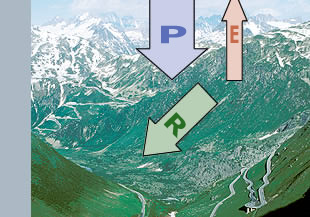 |
|
|
|
|
|
|
Recall the key points of lesson A2. Water relations of alpine ecosystems are driven by four components:
The shorter the season, the less precipitation is needed to meet evaporative demand. Since precipitation tends to increase with elevation in most extratropical mountains, and season length decreases, the water balance becomes increasingly positive with elevation (Fig. 1). The increasingly positive water balance
Whether or not alpine ecosystems at higher latitudes suffer from periodic water shortage is thus, in essence, a question of soil water storage, hence soil depth and soil quality. |
1 - Altitudinal variation of annual precipitation, evapotranspiration, and runoff.
2 - Precipitation, evapotranspiration, and runoff. |
29 August 2011 |
||
| |
||

